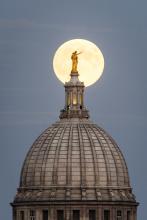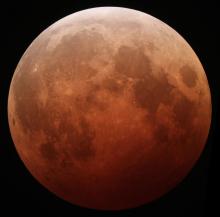Listen to today's episode of StarDate on the web the same day it airs in high-quality streaming audio without any extra ads or announcements. Choose a $8 one-month pass, or listen every day for a year for just $30.
You are here
Moon and Companions
The Moon maneuvers through a crowded region of the sky the next few nights, past a couple of planets and some bright stars.
The Moon is in its waxing crescent phase. The “crescent” part of that description is obvious. The “waxing” part means the crescent is getting fatter by the night. Tonight, the Sun lights up only about eight percent of the Moon’s Earth-facing hemisphere. By tomorrow night, it’ll be about 13 percent, and by Thursday night, about 21 percent.
If we could see the Moon’s backside — the hemisphere that’s always hidden — the lighting would be just the opposite. It would be about 92 percent “full” tonight, but less full night by night.
Those changes are a result of the Moon’s orbit around Earth. The Moon passed between Earth and the Sun on Saturday night. Now, it’s pulling away from the Sun, so more and more of the Earth-facing hemisphere faces the Sun. That means more daylight — and a fatter crescent. The Moon will reach first quarter on Monday, moving into its gibbous phase — and headed toward full on July 3rd.
Watch the crescent Moon and its companions over the next few nights. Tonight, brilliant Venus, the “evening star,” stands to its upper left. Fainter orange Mars is farther along the same line, with Regulus, the heart of the lion, farther still. The twins of Gemini are close to the lower right of the Moon tonight — ready to disappear in the twilight.
Script by Damond Benningfield





